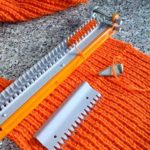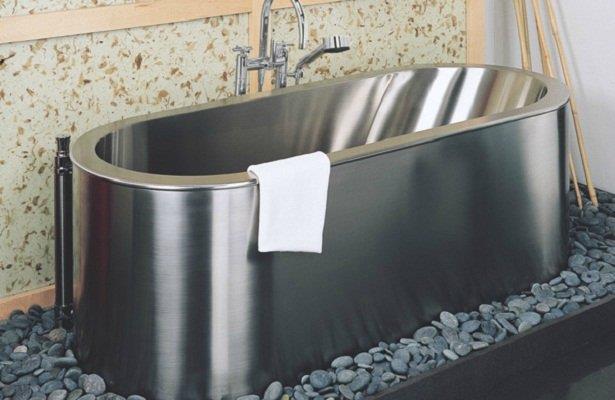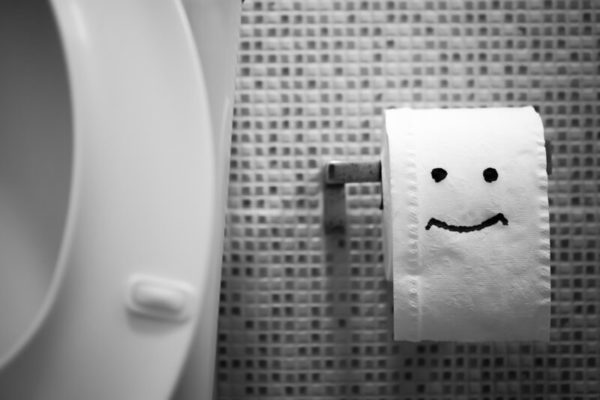Replacing the bathtub trim
No matter how beautiful and expensive a bathtub is, over time it becomes unusable. However, before changing it, you need to understand how the drain works. There are special holes in the bathtub for water drainage. The pipe system ensures the tightness of the drainage system. This whole structure is called a bathtub trim. Its correct installation will allow you to avoid a flood in the room, and, as a result, unpleasant showdowns with neighbors.
The content of the article
What does the harness consist of?
The piping system includes holes for drainage and overflow. Water is discharged through the drain hole, and the overflow hole allows you to control the water level in the bathroom. The harness is not difficult to install, so it is very often used.
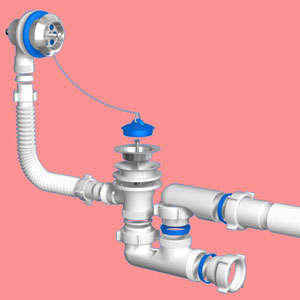 Having understood what a harness is, it’s time to clarify the issue of the types of equipment used. There are different types of harnesses, they differ in material, installation method and design. The material is predominantly metal or plastic. Even though plastic is inexpensive, it can last quite a long time.
Having understood what a harness is, it’s time to clarify the issue of the types of equipment used. There are different types of harnesses, they differ in material, installation method and design. The material is predominantly metal or plastic. Even though plastic is inexpensive, it can last quite a long time.
It is immune to the action of chemical reagents, therefore it is widespread.But despite its positive qualities, plastic is afraid of mechanical damage, which is a problem during installation.
This is due to the fact that during work it becomes necessary to trim or extend elements of the plastic structure, as well as the appearance of various nicks that need to be cleaned.
Metal straps are no less functional, but they also have their drawbacks. They are quite difficult to install and tend to get dirty. Yes, and they are quite expensive.
Reference! Metal strapping is made of copper, brass or polished stainless steel.
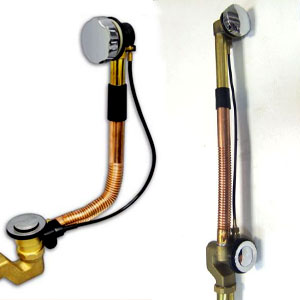
Strapping options
As already mentioned, harnesses are divided into several types. The classification depends on two parameters: design and material. The following types of design are distinguished:
- universal type systems;
- semi-automatic systems;
- automatic type systems.
Universal type system piping
This is the simplest and most common type. It is used in almost any bathtub: acrylic, steel, cast iron. 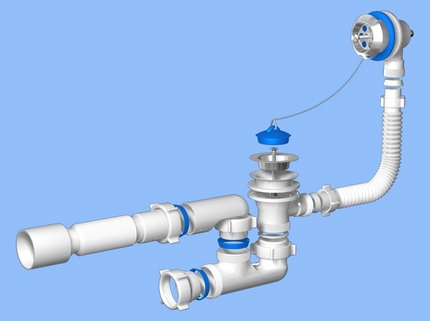
Components of the system:
- The neck of the drain hole. Its kit includes a metal plate on which a plug is installed.
- Overflow neck. It also comes with an overlay.
- The most important part of the entire system is the siphon. It ensures water drains into the sewer and prevents sewage odors from entering the rooms. Siphons can be collapsible or solid.
- Corrugated hose. It is used to connect the drain and overflow necks.Installation is carried out by putting it on the fitting and fastening it with union nuts.
There is a grill on the outside of the overflow hole, and a receiving unit is connected from the inside. A drain pipe is attached to the receiving block, which is connected to the lower outlet using a pipe.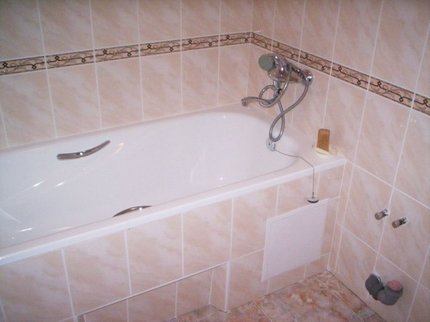
Universal harnesses have virtually no moving parts, so they are considered the most practical.
Semi-automatic systems
The design of this type of system includes a rotating lever that allows you to close the drain neck. It is very convenient to use, even if you are lying in the bath. With proper skill, you can even open it with your toes.
The operating principle of this system is mechanical. The device begins to operate when the valve, which is installed on the neck of the overflow hole, moves. The valve is connected using a cable to another lever, which is located in the drain neck.
Rotation allows you to tighten or loosen the cable, which raises or lowers the plug that closes the drain hole.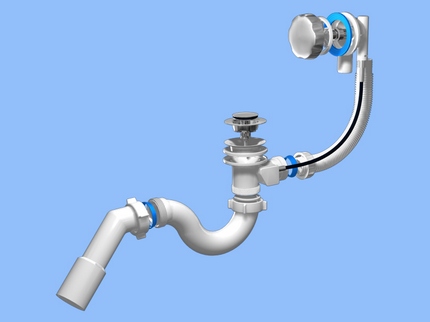
Reference! The advantage of this system is its convenience. But the main disadvantage is the fragility of the structure. Excessive force may damage the lever.
Automatic systems
Automatic systems have no cables or other fragile parts. The water is drained by pressing the plug.
A spring and a lock are installed under the plug. The spring, when the plug presses on it, pushes the latter out. One more press and the drain is blocked.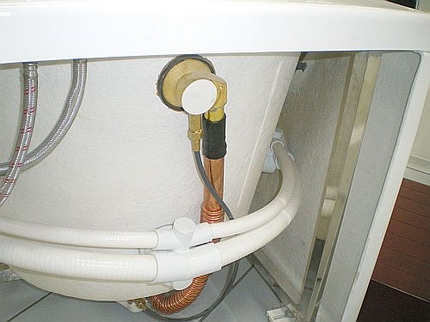
Reference! All trim elements can have different colors. They are painted white, bronze, gold or silver.
The disadvantage of this system is the small size of the hole through which water flows, which leads to the accumulation of hair and debris.
If the device is of poor quality, then its disadvantage is the possibility of breakdown, which is very difficult to fix on your own. The solution to the problem is to completely replace the kit.
Reference! To avoid paying extra, buy a device only from time-tested manufacturers. The best option is a metal harness.
How to install or replace a harness
Installation of a universal type system can be done on your own. It is better to entrust the installation of semi-automatic and automatic systems to professionals.
Before starting work, prepare everything you need:
- drainage system;
- a hacksaw or grinder;
- screwdriver;
- napkins;
- sealant.
Installation of the harness consists of several stages.
Removing the spent harness
Before you begin installing a new drain system, you need to clean the entire bathtub and get rid of the old device.
The elements of the plastic system can be easily unscrewed. In special cases, they can simply be broken off. To remove metal trim elements, you will need a grinder.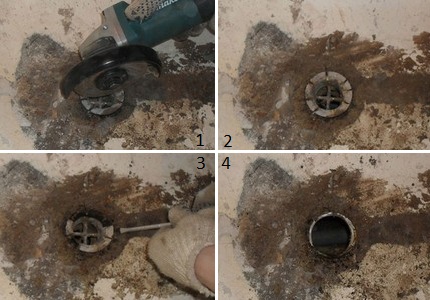
If it is difficult to get to the bottom of the bathtub, then it is better to turn it over. Soak a cloth in the cleaning solution and remove any dirt.
Installation of drain and overflow necks
Both of these elements are constructed in the same way. There is a faceplate, a neck, a mounting screw and rubber gaskets. We remove all irregularities and burrs from the neck and clean it with sandpaper.
The drain hole must be wiped so that no moisture remains. Then you need to disconnect the grates from the drain and overflow pipes.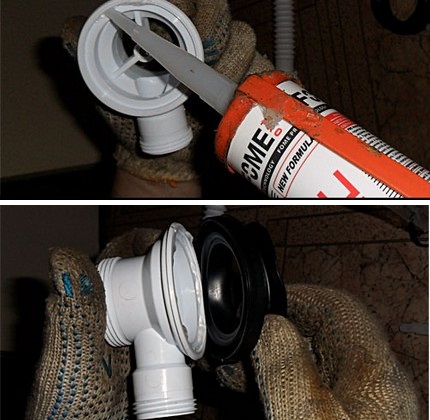
We install the fastening bolt in the center of the lining, install it with the other side into the overflow neck, and then tighten it.
Attention! When tightening, do not use much force, otherwise the parts may be damaged.
The overflow system is installed in the same way.
Siphon installation
The siphon consists of two parts that need to be connected.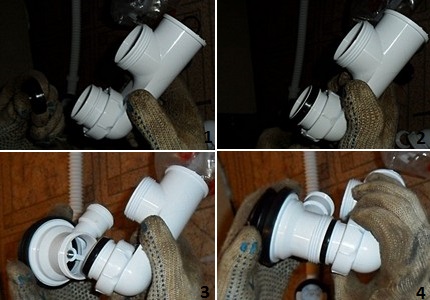
The small element is inserted into the large one, after which the nut is tightened. The small element must maintain its mobility along the axis.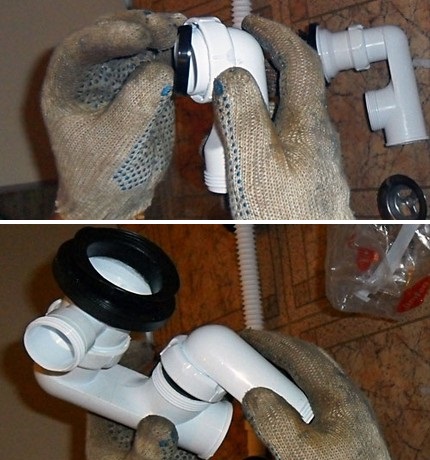
Joining parts
To connect the lower part of the drain system and the upper overflow system with corrugation, nuts are put on the ends of the pipes. In this case, it is necessary to tighten the cone-shaped gaskets. Their thick side should face the nut.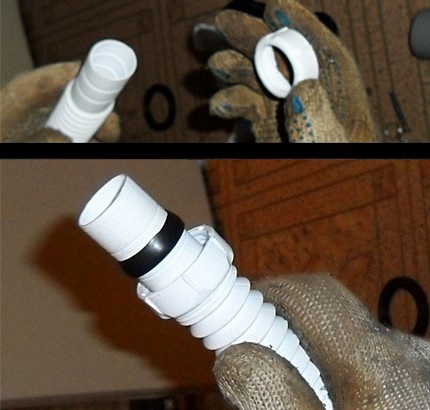
The corrugation easily stretches, which makes it easy to insert it into the pipe. In some models, the corrugation is connected without nuts. It is simply put on the fitting.
After attaching the siphon to the drain neck, it must be secured with a nut. Don't forget about the gasket.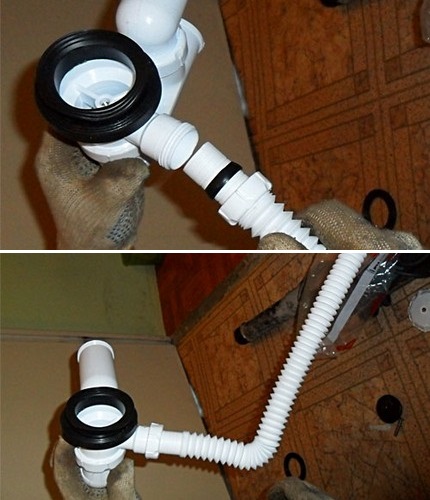
When all the elements are in their proper places, we put the bathtub in its original position. Now you need to check if everything is assembled correctly.
The floor under the siphon is covered with newspaper and water is supplied. If something is assembled incorrectly, moisture will immediately be noticeable on the newspaper. If leaks are visible, then parts of the siphon need to be tightened.
If this does not bring a positive result, then it is necessary to lubricate all structural elements with silicone sealant.
Attention! If the product is used incorrectly, then even a high-quality harness made from any material will become unusable.
A drain and overflow system is not a panacea. It will not give complete confidence that your neighbors will not be flooded by you. Always monitor the amount of water in the bath.

